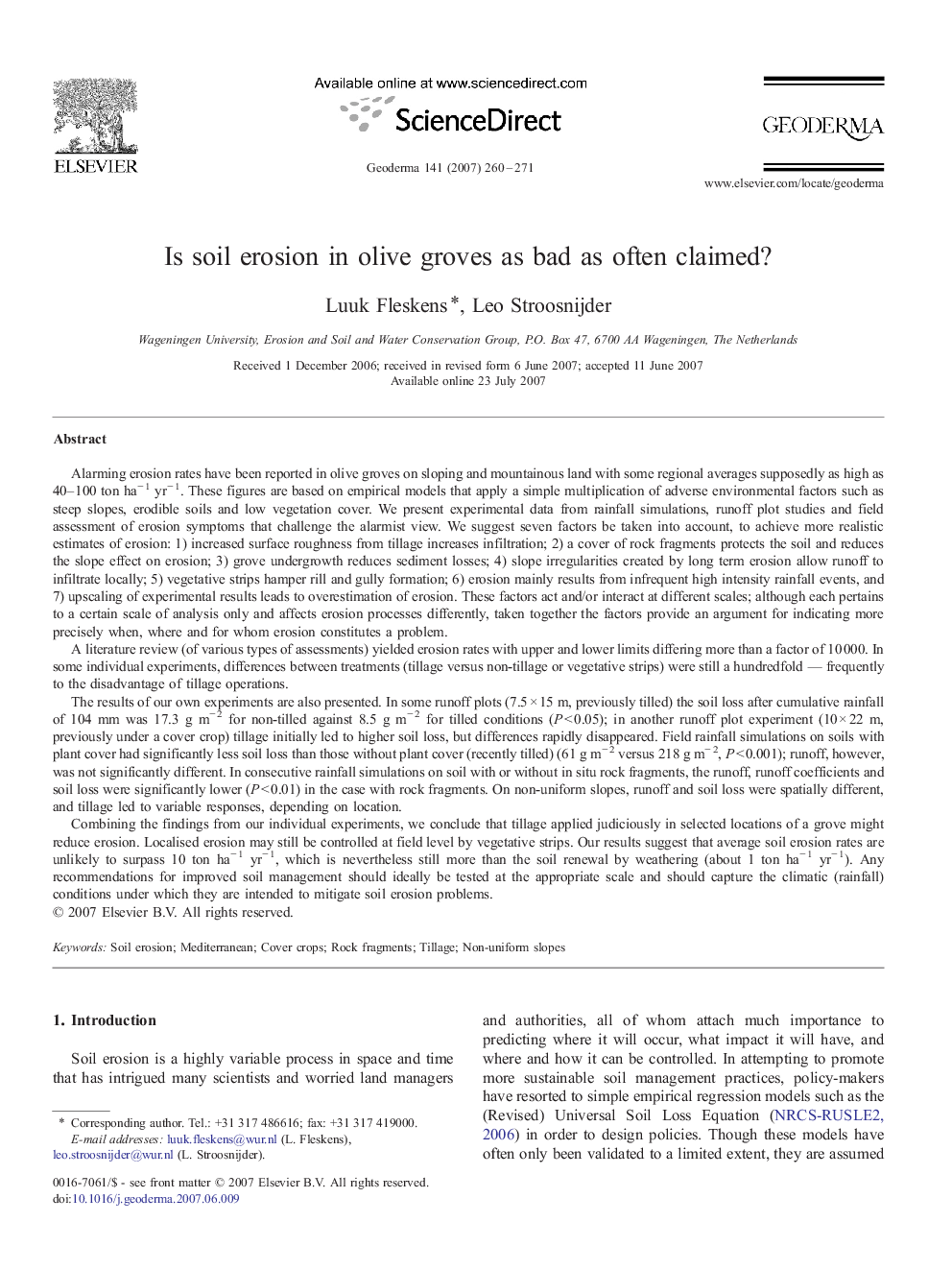| کد مقاله | کد نشریه | سال انتشار | مقاله انگلیسی | نسخه تمام متن |
|---|---|---|---|---|
| 4574918 | 1629550 | 2007 | 12 صفحه PDF | دانلود رایگان |

Alarming erosion rates have been reported in olive groves on sloping and mountainous land with some regional averages supposedly as high as 40–100 ton ha− 1 yr− 1. These figures are based on empirical models that apply a simple multiplication of adverse environmental factors such as steep slopes, erodible soils and low vegetation cover. We present experimental data from rainfall simulations, runoff plot studies and field assessment of erosion symptoms that challenge the alarmist view. We suggest seven factors be taken into account, to achieve more realistic estimates of erosion: 1) increased surface roughness from tillage increases infiltration; 2) a cover of rock fragments protects the soil and reduces the slope effect on erosion; 3) grove undergrowth reduces sediment losses; 4) slope irregularities created by long term erosion allow runoff to infiltrate locally; 5) vegetative strips hamper rill and gully formation; 6) erosion mainly results from infrequent high intensity rainfall events, and 7) upscaling of experimental results leads to overestimation of erosion. These factors act and/or interact at different scales; although each pertains to a certain scale of analysis only and affects erosion processes differently, taken together the factors provide an argument for indicating more precisely when, where and for whom erosion constitutes a problem.A literature review (of various types of assessments) yielded erosion rates with upper and lower limits differing more than a factor of 10 000. In some individual experiments, differences between treatments (tillage versus non-tillage or vegetative strips) were still a hundredfold — frequently to the disadvantage of tillage operations.The results of our own experiments are also presented. In some runoff plots (7.5 × 15 m, previously tilled) the soil loss after cumulative rainfall of 104 mm was 17.3 g m− 2 for non-tilled against 8.5 g m− 2 for tilled conditions (P < 0.05); in another runoff plot experiment (10 × 22 m, previously under a cover crop) tillage initially led to higher soil loss, but differences rapidly disappeared. Field rainfall simulations on soils with plant cover had significantly less soil loss than those without plant cover (recently tilled) (61 g m− 2 versus 218 g m− 2, P < 0.001); runoff, however, was not significantly different. In consecutive rainfall simulations on soil with or without in situ rock fragments, the runoff, runoff coefficients and soil loss were significantly lower (P < 0.01) in the case with rock fragments. On non-uniform slopes, runoff and soil loss were spatially different, and tillage led to variable responses, depending on location.Combining the findings from our individual experiments, we conclude that tillage applied judiciously in selected locations of a grove might reduce erosion. Localised erosion may still be controlled at field level by vegetative strips. Our results suggest that average soil erosion rates are unlikely to surpass 10 ton ha− 1 yr− 1, which is nevertheless still more than the soil renewal by weathering (about 1 ton ha− 1 yr− 1). Any recommendations for improved soil management should ideally be tested at the appropriate scale and should capture the climatic (rainfall) conditions under which they are intended to mitigate soil erosion problems.
Journal: Geoderma - Volume 141, Issues 3–4, 15 October 2007, Pages 260–271